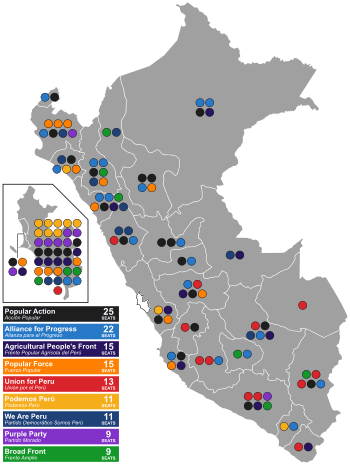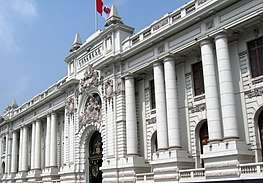2020 Peruvian parliamentary election
Early parliamentary elections were held in Peru on 26 January 2020.[1] The elections were called after President Martín Vizcarra dissolved the Congress of the Republic on 30 September 2019.[1]
| |||||||||||||||||||||||||||||||||||||||||||||||||||||||||||||||||||||||||||||||||||||||||||||||||||||||||
All 130 seats in the Congress of Peru 66 seats needed for a majority | |||||||||||||||||||||||||||||||||||||||||||||||||||||||||||||||||||||||||||||||||||||||||||||||||||||||||
|---|---|---|---|---|---|---|---|---|---|---|---|---|---|---|---|---|---|---|---|---|---|---|---|---|---|---|---|---|---|---|---|---|---|---|---|---|---|---|---|---|---|---|---|---|---|---|---|---|---|---|---|---|---|---|---|---|---|---|---|---|---|---|---|---|---|---|---|---|---|---|---|---|---|---|---|---|---|---|---|---|---|---|---|---|---|---|---|---|---|---|---|---|---|---|---|---|---|---|---|---|---|---|---|---|---|
| Opinion polls | |||||||||||||||||||||||||||||||||||||||||||||||||||||||||||||||||||||||||||||||||||||||||||||||||||||||||
| Registered | 24,812,087 | ||||||||||||||||||||||||||||||||||||||||||||||||||||||||||||||||||||||||||||||||||||||||||||||||||||||||
| Turnout | 74.07% ( | ||||||||||||||||||||||||||||||||||||||||||||||||||||||||||||||||||||||||||||||||||||||||||||||||||||||||
| |||||||||||||||||||||||||||||||||||||||||||||||||||||||||||||||||||||||||||||||||||||||||||||||||||||||||
 Results of the election. | |||||||||||||||||||||||||||||||||||||||||||||||||||||||||||||||||||||||||||||||||||||||||||||||||||||||||
 |
|---|
| This article is part of a series on the politics and government of Peru |
| Constitution |
|
|
|
|
Autonomies
|
|
|
|
|
|
|
All 130 congressmen corresponding to the 26 electoral districts were elected to office for the remainder of the 2016–2021 congressional period. It was the seventh parliamentary election under the 1993 Constitution, which created the current Congress of the Republic of Peru.
Background
On 30 September 2019, the President of the Council of Ministers, Salvador del Solar, set forth a vote of confidence before the Congress for refusing to pass a bill that modified the election process of judges of the Constitutional Court. The vote of confidence sought to stop the election of magistrates, modify the Organic Law of the Constitutional Court and the designation of the tribunes. However, the Plenary Session of Congress decided to continue with the election of magistrates, and ignored the vote of confidence presented by Del Solar. President Martín Vizcarra considered this a vote of no confidence in his Cabinet,[2] and proceeded with the dissolution of Congress and the call for new elections according to Article 134 of the constitution:[3]
The President of the Republic is empowered to dissolve the Congress if it has censured or voted down two Councils of Ministers.

The decree of dissolution also called for new congressional elections to replace the existing congress.[4] Under the law, elections are to be held within four months of the date of dissolution, without altering the pre-existing electoral system, and the Congress cannot be dissolved in the last year of the congressional term, which would be 2021. Once the Congress is dissolved, the Permanent Congressional Committee still remains in operation, which cannot be dissolved.
Schedule
The schedule of activities of the congressional elections of Peru of 2020:
| Electoral schedule | |
|---|---|
| Call for elections | 30 September 2019 |
| Sending the list of the initial register by the National Registry of Identification and Civil Status (RENIEC) to the JNE | 7 October 2019 |
| The period for party elections begins | 11 October 2019 |
| Last day to submit resignations to apply for another political organization | |
| Last day to register political alliances | 31 October 2019 |
| End of the period for party elections | 6 November 2019 |
| Approval of the electoral roll | 16 November 2019 |
| Approval of the electoral roll | |
| Deadline for submission of candidate list | |
| Closing of the Registry of political organizations | 18 November 2019 |
| Deadline for the publication of accepted lists | 3 December 2019 |
| Deadline for exclusion, resignation and withdrawal of candidates December | 27 December 2019 |
| 2020 Congressional election day | 26 January 2020 |
Electoral system
The 130 members of Congress are elected in 26 multi-member constituencies using open list proportional representation. To enter Congress, parties must either cross the 5% electoral threshold at the national level, or win at least seven seats in one constituency. Seats are allocated using the D'Hondt method.[5][6]
Results

The election was the most divided in Peruvian history, with no party receiving more than 11% of the vote. The Fujimorist Popular Force, the largest party in the previous legislature, lost most of its seats, and the American Popular Revolutionary Alliance (APRA) had its worst ever election result, failing to win a seat for the first time since before the 1963 elections. New or previously minor parties such as Podemos Perú, the Purple Party and the Agricultural People's Front had good results. Contigo, the successor to former president Pedro Pablo Kuczynski's Peruvians for Change party, failed to win a seat and received only around 1% of the vote. The result was seen as representative of public support for president Martín Vizcarra's anti-corruption reform proposals.
 | ||||||||
| Party | Votes | % | Seats | +/– | ||||
|---|---|---|---|---|---|---|---|---|
| Popular Action | 1,518,171 | 10.26 | 25 | +20 | ||||
| Podemos Perú | 1,240,716 | 8.38 | 11 | New | ||||
| Agricultural People's Front | 1,240,084 | 8.38 | 15 | New | ||||
| Alliance for Progress | 1,178,020 | 7.96 | 22 | [lower-alpha 2] | ||||
| Purple Party | 1,095,491 | 7.40 | 9 | New | ||||
| Popular Force | 1,081,174 | 7.31 | 15 | –58 | ||||
| Union for Peru | 1,001,716 | 6.77 | 13 | New | ||||
| Broad Front | 911,701 | 6.16 | 9 | –11 | ||||
| We Are Peru | 895,700 | 6.05 | 11 | [lower-alpha 2] | ||||
| Together for Peru | 710,462 | 4.80 | 0 | New | ||||
| Christian People's Party | 590,378 | 3.99 | 0 | 0 | ||||
| Direct Democracy | 543,956 | 3.68 | 0 | 0 | ||||
| Perú Libre | 502,898 | 3.40 | 0 | New | ||||
| APRA | 402,330 | 2.72 | 0 | –5 | ||||
| Go on Country | 373,113 | 2.52 | 0 | New | ||||
| Perú Patria Segura | 350,121 | 2.37 | 0 | New | ||||
| Go Peru | 311,413 | 2.10 | 0 | New | ||||
| National United Renaissance | 265,564 | 1.79 | 0 | New | ||||
| National Solidarity Party | 221,123 | 1.49 | 0 | New | ||||
| Peru Nation | 206,128 | 1.39 | 0 | New | ||||
| Contigo | 158,120 | 1.07 | 0 | New | ||||
| Invalid/blank votes | 3,570,709 | – | – | – | ||||
| Total | 18,369,088 | 100 | 130 | 0 | ||||
| Registered voters/turnout | 24,812,087 | 74.07 | – | – | ||||
| Source: ONPE | ||||||||
Notes
- Compared to the turnout for just the Congressional elections in the 2016 general election
- Part of the Alliance for the Progress of Peru coalition in the 2016 general election
References
- Peru’s political storm: a timeline of events Los Angeles Times, 4 October 2019
- "Disolución del Congreso | Martín Vizcarra | 84% de peruanos apoya la disolución del Congreso". RPP (in Spanish). Retrieved 2019-10-07.
- "Peru's president dissolves Congress to push through anti-corruption reforms". The Guardian. 1 October 2019. ISSN 0261-3077. Retrieved 1 October 2019.
- "Peru's vice-president resigns amid power struggle". BBC News. 2 October 2019. Retrieved 2 October 2019.
- Peru IFES
- Resultados Congresales ONPE







